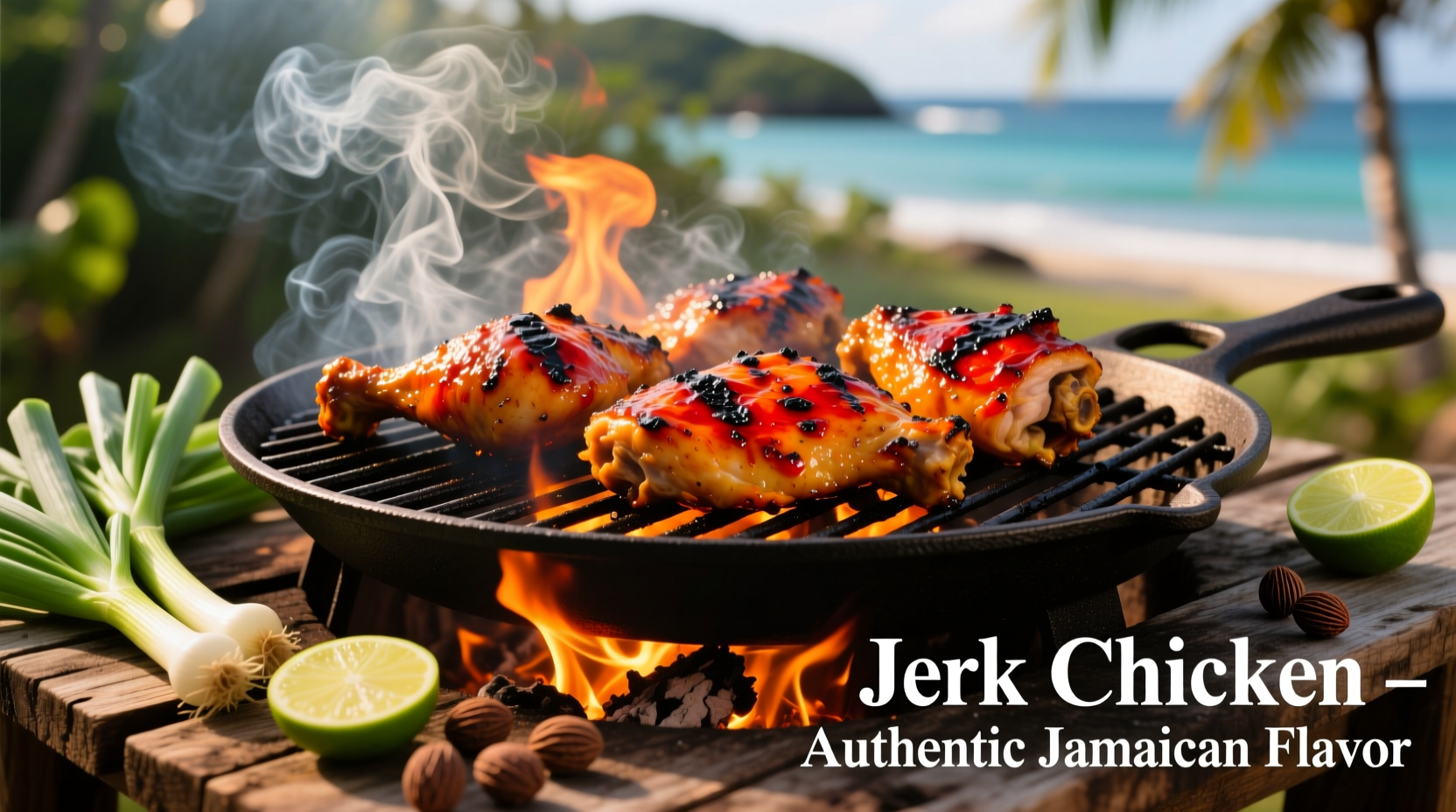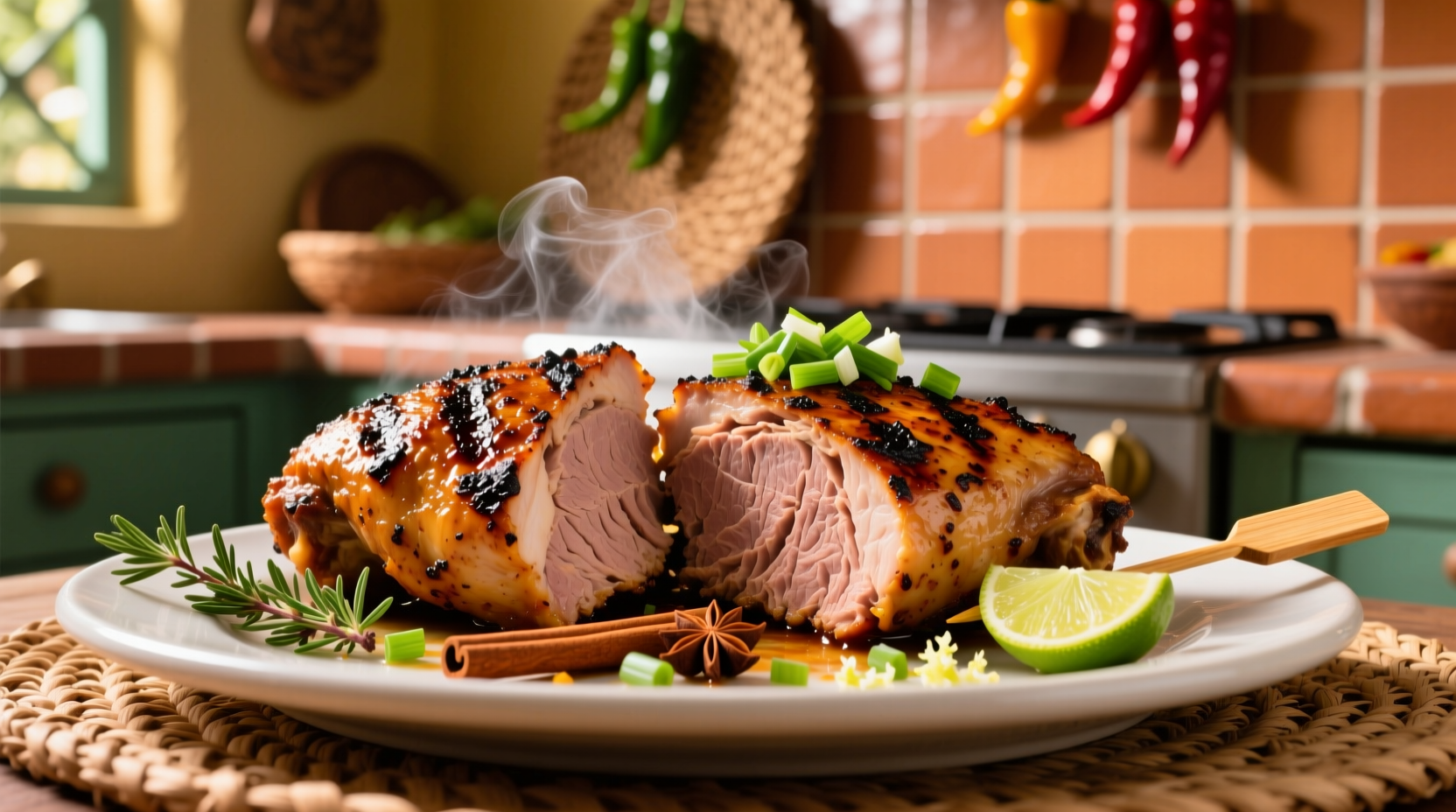Ever wondered what makes Jamaican jerk chicken so uniquely addictive? This iconic Caribbean dish offers a symphony of flavors that dance across your taste buds in perfect harmony. Forget one-dimensional spicy foods—authentic jerk chicken presents a sophisticated interplay of heat, sweetness, earthiness, and smokiness that defines Jamaica's culinary identity.
The Essential Flavor Components
Understanding jerk chicken's taste requires breaking down its signature elements. At its core, jerk seasoning creates what food scientists call "flavor layering"—where multiple taste sensations unfold sequentially rather than hitting all at once.
| Flavor Component | Primary Source | Sensory Experience |
|---|---|---|
| Fiery Heat | Scotch bonnet peppers | Gradual building warmth (100,000-350,000 SHU) |
| Warm Sweetness | Allspice berries (pimento) | Clove-cinnamon-nutmeg fusion |
| Earthy Depth | Thyme and green onions | Grassy, herbal foundation |
| Smoky Char | Pimento wood cooking | Subtle wood-fire complexity |
| Citrus Brightness | Lime juice and scallions | Cleansing acidity that balances richness |
How the Flavor Unfolds When You Eat It
Your first encounter with authentic jerk chicken creates a distinctive sensory journey:
- Initial impression: Aromatic smoke and citrus notes hit your nose before the first bite
- First contact: Slight charred crispness gives way to tender, juicy meat
- Mid-palate: Warm allspice and thyme flavors emerge (not immediately hot)
- Heat development: Scotch bonnet heat builds gradually over 15-30 seconds
- Finish: Complex blend of sweet, spicy, and smoky notes lingers pleasantly
This carefully orchestrated flavor progression explains why jerk chicken remains beloved worldwide. Unlike many spicy dishes that assault your palate, jerk's heat serves as a complement rather than the main event.
Evolution of Jerk Cooking Techniques
The distinctive taste profile developed through centuries of culinary adaptation. Historical records from Jamaica's Institute of Jamaica show how indigenous Taino people originally slow-cooked meat over pimento wood fires. When African Maroons escaped slavery in the 17th century, they combined these techniques with their own spice knowledge:
- Pre-1655: Taino people used "barbacoa" pits for slow cooking with local peppers
- 1655-1739: Maroon communities added allspice, thyme, and scotch bonnets to preservation rubs
- Late 18th century: Sugar cane production introduced sweet elements to the rub
- 1940s: Boston Bay became jerk cooking epicenter with specialized pimento wood pits
- 1980s-present: Global popularity led to adaptations while preserving core flavor principles
What Makes Jerk Chicken Different From Other Spicy Dishes
Many confuse jerk chicken with generic "spicy" preparations, but its flavor profile stands apart:
- Not curry: While both use complex spices, jerk relies on allspice as its foundation rather than curry blends
- Not just heat: The scoville rating (100,000-350,000 units) is high, but balanced by sweet and smoky elements
- Wood matters: Authentic preparation over pimento wood adds distinctive notes you won't get from charcoal
- Marination science: Traditional 24-72 hour marination allows enzymes in scallions and lime to tenderize meat while infusing flavor

Regional Variations and Authenticity Markers
While jerk chicken has gained global popularity, authentic versions maintain specific characteristics. The Jamaica Tourist Board's culinary standards identify these markers of genuine preparation:
- Must contain freshly ground allspice berries (not pre-ground)
- Scotch bonnet peppers must be used fresh, not dried or powdered
- Traditional cooking over pimento wood (ackee wood acceptable alternative)
- Marination period of at least 24 hours
Travelers to Jamaica should note that authentic jerk centers in Boston Bay use specific wood types that create subtle flavor differences. As documented by the University of the West Indies' food science department, pimento wood contains eugenol compounds that interact uniquely with the spice rub during slow cooking.
What First-Time Eaters Should Expect
If you've never tried authentic jerk chicken, here's what to anticipate:
- The heat builds gradually—you won't immediately feel intense burning
- Sweet allspice notes balance the pepper heat
- Smoky wood flavor permeates the meat (not just surface seasoning)
- Juiciness contrasts with slightly charred exterior
- Aftertaste features complex spice harmony rather than just heat
Many first-timers mistakenly expect immediate fire, but authentic jerk's magic lies in its balanced complexity. The National Library of Jamaica's culinary archives note that traditional jerk masters carefully calibrate scotch bonnet quantity based on individual tolerance—a practice lost in many commercial versions.
Avoiding Common Jerk Chicken Misconceptions
Several myths cloud understanding of jerk chicken's true flavor profile:
- Myth: Jerk is just about extreme heat
Reality: Heat serves as one component in a complex flavor orchestra - Myth: All jerk seasoning contains soy sauce
Reality: Traditional recipes use only Caribbean-native ingredients - Myth: Jerk must be extremely spicy
Reality: Authentic versions balance heat with other elements (mild versions exist) - Myth: Jerk originated as a preservation method only
Reality: While preservation was important, flavor development was equally crucial
Understanding these distinctions helps appreciate jerk chicken's sophisticated flavor profile beyond simple "spicy food" categorization.
Frequently Asked Questions
Does jerk chicken taste like curry chicken?
No, jerk chicken has a distinctly different flavor profile from curry chicken. While both feature complex spices, jerk relies on allspice as its foundation with scotch bonnet heat, whereas curry uses turmeric-based blends. Jerk's smoky wood notes and citrus elements create a uniquely Caribbean taste unlike Indian or Southeast Asian curries.
Is jerk chicken supposed to be extremely spicy?
Authentic jerk chicken features heat that builds gradually rather than overwhelming the palate. Traditional preparation balances scotch bonnet peppers with sweet allspice, aromatic thyme, and citrus elements. While spicy, the heat serves as one component in a complex flavor profile rather than the dominant characteristic.
What gives jerk chicken its distinctive smoky flavor?
Authentic jerk chicken gets its signature smokiness from slow cooking over pimento wood (allspice tree wood). The wood contains eugenol compounds that interact with the spice rub during the 3-4 hour cooking process, creating complex flavor compounds you can't achieve with charcoal or gas grilling.
Why does jerk chicken taste different from other spicy grilled chicken?
Jerk chicken's unique taste comes from its specific spice blend (especially fresh allspice berries and scotch bonnet peppers), 24-72 hour marination process, and traditional cooking over pimento wood. Unlike simple hot spice rubs, jerk features layered flavors where heat builds gradually while sweet, smoky, and herbal notes remain prominent throughout the eating experience.











 浙公网安备
33010002000092号
浙公网安备
33010002000092号 浙B2-20120091-4
浙B2-20120091-4